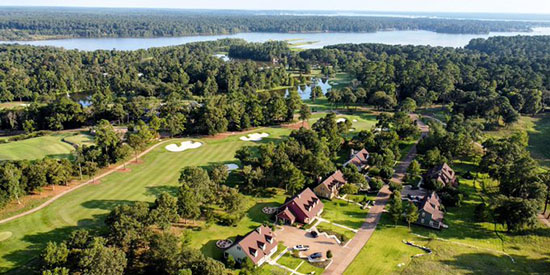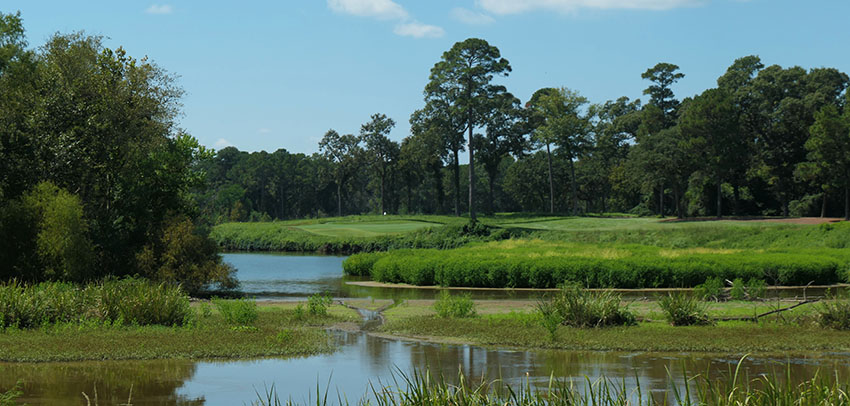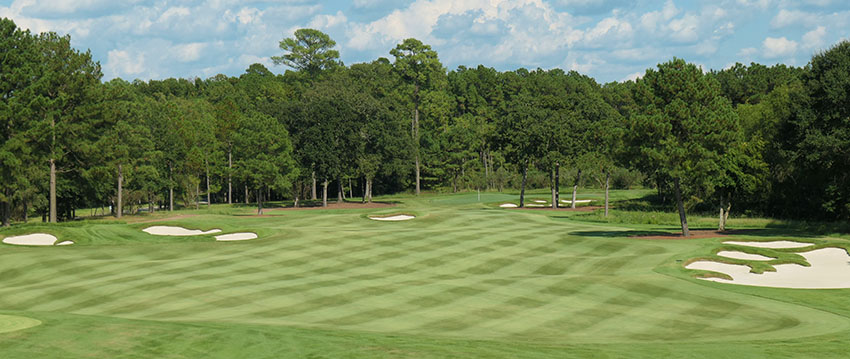Whispering Pines: a worthy host for the Olympics of amateur golf
10/1/2021 | by Chris Brauner of AmateurGolf.com
see also: Whispering Pines Golf Club, All Course Reviews, The Spirit International Amateur Golf Championship, Whispering Pines Golf Club

Not your ordinary club, this mysterious course and host of The Spirit was built to promote amateur golf and philanthropic causes
Some of the most spectacular golf destinations to emerge in the past thirty years have been borne of the dream of a single visionary.
Dick Youngscap bought 8000 acres from a rancher deep in the Sand Hills of Nebraska, from which Sand Hills Golf Club was created in 1992. Mike Keiser purchased a plot of remote linksland on the southern coast of Oregon, from which emerged the Bandon Dunes Golf Resort in 1999. Other courses following this “build it and they will come” model of finding interesting land in faraway locales include Sand Valley in Wisconsin and Cabot Links in Nova Scotia (Keiser) and Barnbougle Dunes in Tasmania (Greg Ramsey).
While those visionaries imagined creating a world-class golf experience for their resort guests and members, another wanted to go a step further and did so, with far less fanfare.
Whispering Pines Golf Club has long been somewhat of a mystery to Texas golfers. It has been consistently ranked as the #1 course in Texas and yet it can be hard to find anyone who has played it or even knows where it is. It is not remote by Sand Hills standards – the city of Houston is 90 minutes away – but it is nicely hidden in an area of the state that no one will ever accidentally stumble upon, which is just how owner, founder, and philanthropist Corbin Robertson, Jr. likes it.

Whispering Pines (Tim Schmitt/Golfweek photo)
Robertson, whose fortune was made in oil and coal, created Whispering Pines Golf Club as a vessel for philanthropy as much as a golf destination. Robertson purchased a heavily wooded plot of land on the north shore of Lake Livingston in East Texas, on which he operated a youth summer camp for years until a pine beetle infestation threatened the property and forced him to clear cut some of the trees.
Seeing an opportunity, Robertson, who had worked with Pete Dye to design Austin Country Club, decided to selectively harvest the timber to create clearings for eighteen holes of golf. For a while, campers could play what Robertson calls “olf” – that is, golf without the greens – until he decided to commission Chet Williams of the Nicklaus design team to build a proper championship course.
Robertson decided from the start that Whispering Pines would not be another private club just catering to a membership of elites, but rather as a means for promoting amateur golf and his vast array of philanthropic pursuits.
And so, in 1999, the year before the course opened, Robertson created the World Health and Golf Association (now known as the Spirit Golf Association), with the mission “for philanthropic minded people to support charitable causes, enjoy membership privileges at a world-class golf property and to conduct The Spirit International Amateur Golf Championship.” Membership revenue is used to support The Spirit, and to benefit affiliated charities like the Houston/Harris County Immunization Registry, Medical Bridges, Inc., and the Houston Food Bank.

The Spirit was introduced to be the Olympics of amateur golf, with players representing 20 countries competing for team and individual medals – like in the Olympics, gold, silver and bronze. That same summer camp, Camp Olympia, serves as the “Olympic Village” for the players. There are opening and closing ceremonies, daily social events, and even a cauldron. The first tournament was conducted in 2001, with future World Golf Hall of Famer, Lorena Ochoa of Mexico, winning three gold medals.
This year, The Spirit turns 20 years old and will again bring the top men and women amateurs from across the world to Whispering Pines. The Spirit Golf Association will pay for all expenses – travel, lodging, food, etc. – that participating national teams would otherwise incur.
The course they will play gives elite players the three things they most want: a difficult but enjoyable championship test, a scenic journey, and immaculate playing conditions.
A Championship Test
The world’s best men’s and women’s amateur golfers play very different games, so it can be a real trick for a single golf course to test both equally. How does Whispering Pines do this?
“If you look at all the bunkering, this is a second-shot course,” says Spirit Vice President Mark Steinbauer. “A second-shot course makes it interesting for everyone, because it demands accuracy with your irons, putting it on the right quadrant of the greens, playing smart.” He notes that if it were a wide-open “bombs-away” type of course it might overly favor the power game, but players have to think about placing their drive for the ideal approach. Sam Bennett, a senior at Texas A&M who was named to Team USA for The Spirit, concurs. “This is a second-shot golf course, that gives you some room off the tee, and then into the greens your numbers really have to be dialed in. They are big greens, but there are probably four sections on each of the greens, different tiers and ledges where the pins will be.”
A Scenic Journey
The course wanders through the pines, constantly changing direction and moving over and around sandy areas and lakes, until it reaches the final six holes which play alongside Caney Creek and Lake Livingston. These are the holes that will be featured on the TV broadcast, and they are the ones that Robertson is most proud of because it is where his own work is most evident.
“Before Lake Livingston Dam was created in 1970, I improved the shoreline and created islands, peninsulas and wetlands along Caney Creek,” said Robertson in a 2019 interview with Golf Club Atlas. Those features would feature prominently in the future design of the course, and are most evident at the 14th and 15th holes.

The drivable par-4 14th forces a tough decision
Steinbauer says that the 14th will be the key hole for players coming down the stretch. Players will be tempted to drive the green on the boomerang-shaped short par four, but any shot that does not clear the wetlands will require a re-tee. There are other routes with shorter carries, but each one has a smaller area for the ball to land in, forcing the player to decide between precision and power. “It’s a fan favorite and a player protecting a lead has a very tough decision,” he says.
The 15th may be the single most inspiring spot on the entire property. The vision just to create the hole – converting what was a sand bar in Caney Creek into a peninsula green that plays like an island—is matched by the precision the hole requires and the versatility it offers, with tees allowing it to be approached from several angles.
The last three holes, a par-3, a par-5 and a par-4, ratchet up the length and keep water in play as Caney Creek broadens into Lake Livingston. The finishing hole requires two carries over water as the green is framed by Robertson’s residence on the left and a row of flags on the right, each one representing a participating country in The Spirit Amateur.
An Immaculate Playing Surface
For the 2021 Spirit, players will get to experience an entirely new course. In late 2019, Williams returned for a course renovation that saw every green rebuilt, some bunkers added and others removed, tees added and most importantly, a new playing surface – zoysia grass on tees, fairways, and roughs.

The par-4 10th; not a blade of grass out of place
The new zoysia fairways and green surrounds allow the ball to run more, provide excellent fairway lies, and allow a greater variety of shots around the green than the old Bermuda surfaces. The handle heat humidity well, as well as the shade from some of the towering pines, and the abbreviated playing season – the club closes during the summer months and occasionally in the winter – allows the grounds crew to maintain them in beautiful condition.
The greens are likewise kept smooth and quick, and the fact that they are sectioned (and that few rounds are played on the course) means that they don’t get worn down by foot traffic. As Bennett noted, there are different sections, meaning that the effective target is much smaller than what the eye might see, and that trajectory and spin control will be the key to scoring.
Robertson’s dream has evolved to include a nine-hole short course, which was also designed by Williams and was also resurfaced with zoysia.
“We’ve always taken great pride in our excellent course conditions,” said Robertson in 2020 to Richard Humphreys of Golf Course Architecture. “The construction was a response to upholding that standard of excellence. Chet and the team reimagined the course and added some fine-tuning and we’re very pleased to share the new Whispering Pines Golf Club.”
Dick Youngscap bought 8000 acres from a rancher deep in the Sand Hills of Nebraska, from which Sand Hills Golf Club was created in 1992. Mike Keiser purchased a plot of remote linksland on the southern coast of Oregon, from which emerged the Bandon Dunes Golf Resort in 1999. Other courses following this “build it and they will come” model of finding interesting land in faraway locales include Sand Valley in Wisconsin and Cabot Links in Nova Scotia (Keiser) and Barnbougle Dunes in Tasmania (Greg Ramsey).
While those visionaries imagined creating a world-class golf experience for their resort guests and members, another wanted to go a step further and did so, with far less fanfare.

Whispering Pines (Tim Schmitt/Golfweek photo)
Seeing an opportunity, Robertson, who had worked with Pete Dye to design Austin Country Club, decided to selectively harvest the timber to create clearings for eighteen holes of golf. For a while, campers could play what Robertson calls “olf” – that is, golf without the greens – until he decided to commission Chet Williams of the Nicklaus design team to build a proper championship course.
Robertson decided from the start that Whispering Pines would not be another private club just catering to a membership of elites, but rather as a means for promoting amateur golf and his vast array of philanthropic pursuits.
And so, in 1999, the year before the course opened, Robertson created the World Health and Golf Association (now known as the Spirit Golf Association), with the mission “for philanthropic minded people to support charitable causes, enjoy membership privileges at a world-class golf property and to conduct The Spirit International Amateur Golf Championship.” Membership revenue is used to support The Spirit, and to benefit affiliated charities like the Houston/Harris County Immunization Registry, Medical Bridges, Inc., and the Houston Food Bank.

This year, The Spirit turns 20 years old and will again bring the top men and women amateurs from across the world to Whispering Pines. The Spirit Golf Association will pay for all expenses – travel, lodging, food, etc. – that participating national teams would otherwise incur.
The course they will play gives elite players the three things they most want: a difficult but enjoyable championship test, a scenic journey, and immaculate playing conditions.
A Championship Test
The world’s best men’s and women’s amateur golfers play very different games, so it can be a real trick for a single golf course to test both equally. How does Whispering Pines do this?
“If you look at all the bunkering, this is a second-shot course,” says Spirit Vice President Mark Steinbauer. “A second-shot course makes it interesting for everyone, because it demands accuracy with your irons, putting it on the right quadrant of the greens, playing smart.” He notes that if it were a wide-open “bombs-away” type of course it might overly favor the power game, but players have to think about placing their drive for the ideal approach. Sam Bennett, a senior at Texas A&M who was named to Team USA for The Spirit, concurs. “This is a second-shot golf course, that gives you some room off the tee, and then into the greens your numbers really have to be dialed in. They are big greens, but there are probably four sections on each of the greens, different tiers and ledges where the pins will be.”
A Scenic Journey
The course wanders through the pines, constantly changing direction and moving over and around sandy areas and lakes, until it reaches the final six holes which play alongside Caney Creek and Lake Livingston. These are the holes that will be featured on the TV broadcast, and they are the ones that Robertson is most proud of because it is where his own work is most evident.
“Before Lake Livingston Dam was created in 1970, I improved the shoreline and created islands, peninsulas and wetlands along Caney Creek,” said Robertson in a 2019 interview with Golf Club Atlas. Those features would feature prominently in the future design of the course, and are most evident at the 14th and 15th holes.

The drivable par-4 14th forces a tough decision
Steinbauer says that the 14th will be the key hole for players coming down the stretch. Players will be tempted to drive the green on the boomerang-shaped short par four, but any shot that does not clear the wetlands will require a re-tee. There are other routes with shorter carries, but each one has a smaller area for the ball to land in, forcing the player to decide between precision and power. “It’s a fan favorite and a player protecting a lead has a very tough decision,” he says.
The 15th may be the single most inspiring spot on the entire property. The vision just to create the hole – converting what was a sand bar in Caney Creek into a peninsula green that plays like an island—is matched by the precision the hole requires and the versatility it offers, with tees allowing it to be approached from several angles.
The last three holes, a par-3, a par-5 and a par-4, ratchet up the length and keep water in play as Caney Creek broadens into Lake Livingston. The finishing hole requires two carries over water as the green is framed by Robertson’s residence on the left and a row of flags on the right, each one representing a participating country in The Spirit Amateur.
An Immaculate Playing Surface
For the 2021 Spirit, players will get to experience an entirely new course. In late 2019, Williams returned for a course renovation that saw every green rebuilt, some bunkers added and others removed, tees added and most importantly, a new playing surface – zoysia grass on tees, fairways, and roughs.

The par-4 10th; not a blade of grass out of place
The new zoysia fairways and green surrounds allow the ball to run more, provide excellent fairway lies, and allow a greater variety of shots around the green than the old Bermuda surfaces. The handle heat humidity well, as well as the shade from some of the towering pines, and the abbreviated playing season – the club closes during the summer months and occasionally in the winter – allows the grounds crew to maintain them in beautiful condition.
The greens are likewise kept smooth and quick, and the fact that they are sectioned (and that few rounds are played on the course) means that they don’t get worn down by foot traffic. As Bennett noted, there are different sections, meaning that the effective target is much smaller than what the eye might see, and that trajectory and spin control will be the key to scoring.
Robertson’s dream has evolved to include a nine-hole short course, which was also designed by Williams and was also resurfaced with zoysia.
“We’ve always taken great pride in our excellent course conditions,” said Robertson in 2020 to Richard Humphreys of Golf Course Architecture. “The construction was a response to upholding that standard of excellence. Chet and the team reimagined the course and added some fine-tuning and we’re very pleased to share the new Whispering Pines Golf Club.”
Most Popular Articles

2025 PGA TOUR Q-School Guide: Sites, Scores, and Who Advanced
Dec 5, 2025Second Stage is complete and Final Stage awaits at Sawgrass — follow every Q-School leaderboard and the players still chasing
2025 LPGA TOUR Q-Series: Final Qualifying Stage FINAL SCORING
Dec 8, 2025Helen Briem earns medalist honors, 31 players headed to the LPGA next year
Australian Open at Royal Melbourne: Preview, amateur bios, and how to watch
Nov 30, 2025Rory McIlroy headlines one of the championship's top fields in years - at least four amateurs will have their chance at glory
Luke Ringkamp Cruises to Rolex Tournament of Champions Title at TPC San Antonio
Nov 26, 2025One week after committing to Pepperdine, Luke Ringkamp won the Rolex Tournament of Champions by nine shots.Inside Gil Hanse’s Restoration of Baltusrol’s Upper Course: A Return to Tillinghast’s
Dec 11, 2025Renowned architect Gil Hanse reveals how he brought Baltusrol’s Upper Course back to life by honoring A.W. Tillinghast’s originalLoading latest news...
